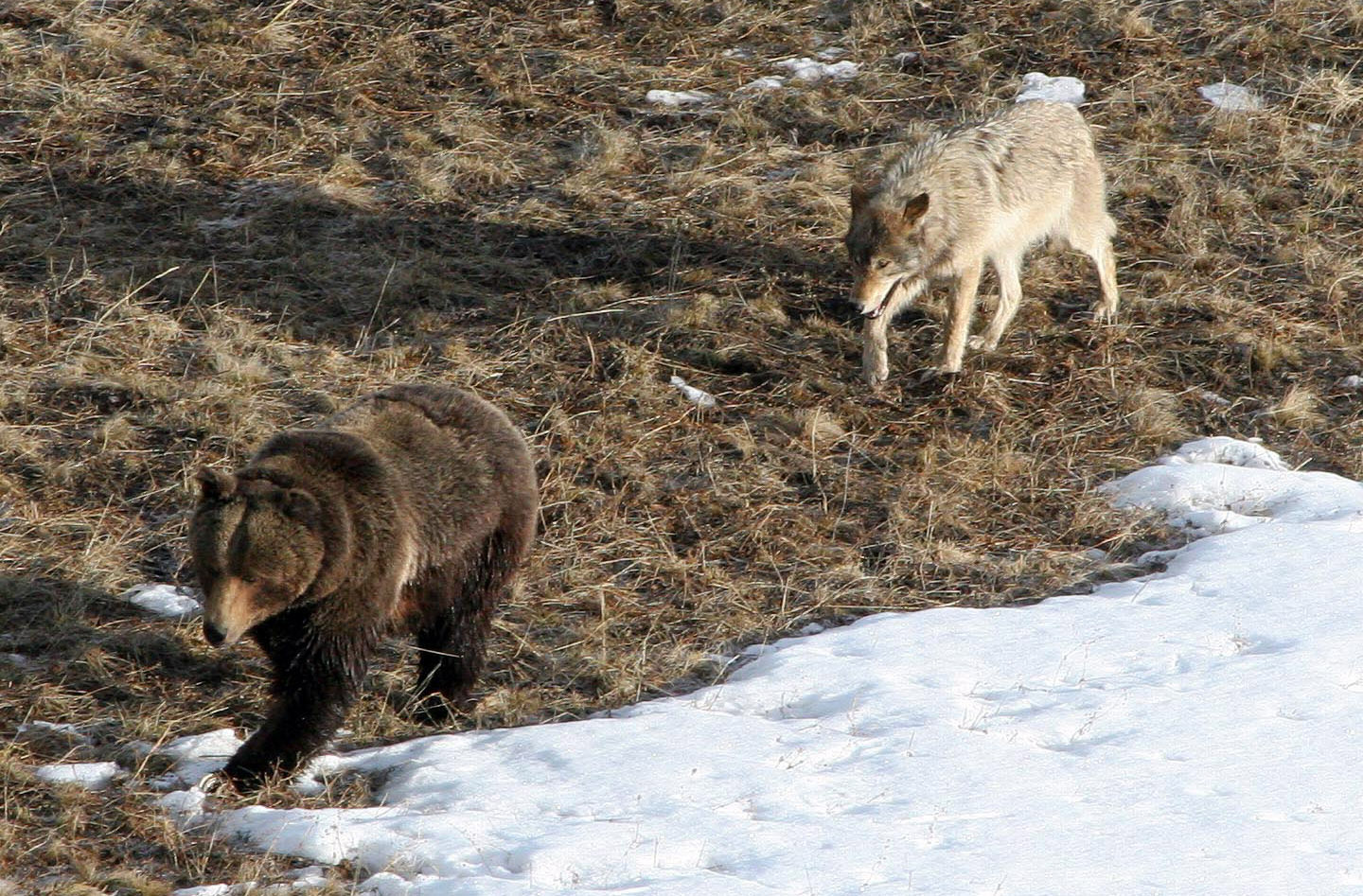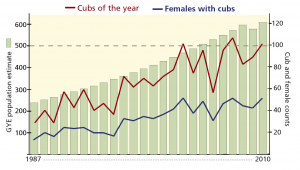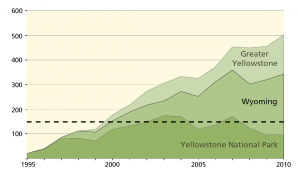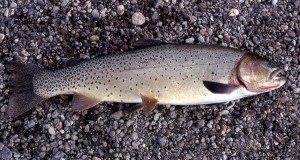
A wolf from the Leopold pack trails a grizzly bear in Yellowstone National Park in spring 2005. (NPS photo by Doug Smith - click to enlarge)
By Ruffin Prevost
National Park Service scientists and collaborators from a wide range of cooperating organizations have released a report documenting the status of dozens of key indicators of the ecological health of Yellowstone National Park, quantifying a mixed bag of success stories and cautionary tales about natural resources in the park.
The 2011 Natural Resource Vital Signs report is meant to help park managers understand the interconnected factors affecting the overall environmental picture in Yellowstone. It presents scientific data on everything from fires and earthquakes to bald eagles and boreal toads.

Data gathered by the National Park Service and cooperating agencies show a steady climb in the greater Yellowstone ecosystem grizzly bear population since 1987. One of the recovery criteria for grizzlies is an ecosystem population of at least 500 bears. (NPS graphic - click to enlarge)
Among its highlights: Yellowstone may be at or near its natural carrying capacity for grizzly bears; the greater Yellowstone area population grew nearly 50 percent from 1990 to 2010; and a swarm of about 2,400 earthquakes from mid-January to mid-February northwest of Old Faithful was the largest such occurrence since 1985.
The Vital Signs report was produced by the Yellowstone Center for Resources, a National Park Service clearinghouse for science and resource management information.
An attempt to reach YCR Chief David Hallac was unsuccessful. According to its annual report, YCR works with various partner agencies and researchers to monitor and report key data to assist park managers in making science-driven decisions.
The report’s findings show how changes in one animal species population can affect others, as well as how tricky in can be to definitively measure a host of interconnected factors in one of the country’s most remote and rugged areas.
In explaining the decline of wolves inside Yellowstone at the same time the animals’ numbers are increasing in areas bordering the park, the report notes that Yellowstone’s wolf population fell to 97 in 2010, the lowest level since 1999.

Data gathered by the National Park Service and cooperating agencies show a decline in gray wolves living inside Yellowstone National Park in recent years, while wolf numbers have climbed in the greater Yellowstone ecosystem. One of the recovery criteria for the animals is a population of at least 150 wolves in Wyoming. (NPS graphic - click to enlarge)
That dip “is attributed in part to a drop in the northern range elk population by more than two-thirds since the mid-1990s, which is attributed in part to predation by wolves, the growing bear population, hunting, and possibly drought-related effects on elk pregnancy and survival,” the report states.
Grizzly bear numbers are estimated at 602 in the greater Yellowstone area, the highest level since recovery efforts began in 1975. Bears have expanded their habitat since then by more than 50 percent, and an estimated 150 grizzlies live entirely or partly within the park.
The number of females producing cubs in the park has not changed much since 1996, the report states, “suggesting that the park may be at or near ecological carrying capacity for grizzly bears.”
Census data shows that the population in the greater Yellowstone area, a multi-county region surrounding Yellowstone and Grand Teton national parks, went from 220,000 in 1990 to 323,000 in 2010.
Though Yellowstone saw more than 3,200 earthquakes in 2010 — the highest level since 1985 — the report states that “a cataclysmic eruption of the Yellowstone volcano is unlikely in the foreseeable future.”
Some parts of the Yellowstone caldera were rising nearly three inches per year, while other sections were subsiding. In general, the caldera has subsided during 2010.

Yellowstone National Park biologists are working to remove invasive lake trout, which feed on native Yellowstone cutthroat trout like the one seen in this 1969 file photo. (NPS photo by William W Dunmire - click to enlarge)
Efforts continue to remove non-native lake trout, which prey on the struggling native Yellowstone cutthroat trout. A combination of lake trout predation, drought, and whirling disease have caused “substantial declines” in cutthroat trout, the report states.
There is depressing news from a program that has used nets to remove nearly 550,000 lake trout from Yellowstone Lake since 1994, with 146,000 of those caught in 2010. More fish, on average, have been caught per unit of net during each year since 2002, the report states, “suggesting that the population has been increasing faster than the fish are being removed.”
The park’s Native Fish Conservation Plan aims to reduce lake trout populations by 25 percent each year “until it collapses to an insignificant level.” The report states that “population modeling suggests this may be possible with an increase in effort.”
Over the next year, YCR plans to use data from the report to develop “desired conditions for many of the indicators,” which will help “establish management targets,” the report states.
Contact Ruffin Prevost at 307-213-9818 or ruffin@yellowstonegate.com.

Oh, wow, the wolf is the biggest animal all times. Wooooooooow. That’s incredible. Long life at the wolf. I love wolves.